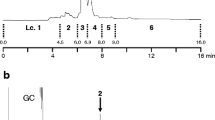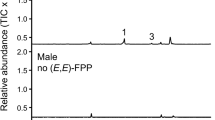Abstract
exo-Brevicomin (exo-7-ethyl-5-methyl-6,8-dioxabicyclo[3.2.1]octane) is an important semiochemical for a number of beetle species, including the highly destructive mountain pine beetle, Dendroctonus ponderosae. It also has been found in other insects and even in the African elephant. Despite its significance, little is known about its biosynthesis. In order to fill this gap and to identify new molecular targets for potential pest management methods, we performed gas chromatography–mass spectrometry analyses of cell cultures and in vitro assays of various D. ponderosae tissues with exo-brevicomin intermediates, analogs, and inhibitors. We confirmed that exo-brevicomin was synthesized by “unfed” males after emerging from the brood tree. Furthermore, in contrast to the paradigm established for biosynthesis of monoterpenoid pheromone components in bark beetles, exo-brevicomin was produced in the fat body, and not in the anterior midgut. The first committed step involves decarboxylation or decarbonylation of ω-3-decenoic acid, which is derived from a longer-chain precursor via β-oxidation, to (Z)-6-nonen-2-ol. This secondary alcohol is converted to the known precursor, (Z)-6-nonen-2-one, and further epoxidized by a cytochrome P450 to 6,7-epoxynonan-2-one. The keto-epoxide is stable at physiological pH, suggesting that its final cyclization to form exo-brevicomin is enzyme-catalyzed. exo-Brevicomin production is unusual in that tissue not derived from ectoderm apparently is involved.






Similar content being viewed by others
References
Arrese EL, Soulages JL (2010) Insect fat body: energy, metabolism, and regulation. Annu Rev Entomol 55:207–225
Aw T, Schlauch K, Keeling CI, Young S, Bearfield JC, Blomquist GJ, Tittiger C (2010) Functional genomics of mountain pine beetle (Dendroctonus ponderosae) midguts and fat bodies. BMC Genomics 11:215
Barkawi LS, Francke W, Blomquist GJ, Seybold SJ (2003) Frontalin: de novo biosynthesis of an aggregation pheromone component by Dendroctonus spp. bark beetles (Coleoptera: Scolytidae). Insect Biochem Mol Biol 33:773–788
Bedard WD, Tilden PE, Wood DL, Silverstein RM, Brownlee RG, Rodin JO (1969) Western pine beetle: field response to its sex pheromone and a synergistic host terpene, myrcene. Science 164:1284–1285
Bellas TE, Brownlee RG, Silverstein RM (1969) Synthesis of brevicomin, principal sex attractant in the frass of the female western pine beetle. Tetrahedron 25:5149–5153
Bligh EG, Dyer WJ (1959) A rapid method of total lipid extraction and purification. Can J Biochem Physiol 37:911–917
Blomquist GJ, Figueroa-Teran R, Aw M, Song M, Gorzalski A, Abbott NL, Chang E, Tittiger C (2010) Pheromone production in bark beetles. Insect Biochem Mol Biol 40:699–712
Borden JH (1985) Aggregation pheromones. In: Kerkut GA, Gilbert LI (eds) Comprehensive insect physiology, biochemistry and pharmacology. Pergamon, Oxford, pp 257–285
Borden JH, Pierce AM, Pierce HDJ, Chong LJ, Stock AJ, Oehlschlager AC (1987) Semiochemicals produced by western balsam bark beetle, Dryocoetes confusus Swaine (Colopetera: Scolytidae). J Chem Ecol 13:823–836
El-Sayed AM (2013) The pherobase: database of insect pheromones and semiochemicals. http://www.pherobase.com. Accessed 27 September 2013
Goodwin T, Eggert M, House S, Weddell M, Schulte B, Rasmussen LEL (2006) Insect pheromones and precursors in female African elephant urine. J Chem Ecol 32:1849–1853
Hall GM, Tittiger C, Andrews GL, Mastick GS, Kuenzli M, Luo X, Seybold SJ, Blomquist GJ (2002a) Midgut tissue of male pine engraver, Ips pini, synthesizes monoterpenoid pheromone component ipsdienol de novo. Naturwissenschaften 89:79–83
Hall GM, Tittiger C, Blomquist GJ, Andrews GL, Mastick GS, Barkawi LS, Bengoa C, Seybold SJ (2002b) Male Jeffrey pine beetle, Dendroctonus jeffreyi, synthesizes the pheromone component frontalin in anterior midgut tissue. Insect Biochem Mol Biol 32:1525–1532
Keeling CI, Blomquist GJ, Tittiger C (2004) Coordinated gene expression for pheromone biosynthesis in the pine engraver beetle, Ips pini (Coleoptera: Scolytidae). Naturwissenschaften 91:324–328
Libbey LM, Ryker LC, Yandell KL (1985) Laboratory and field studies of volatiles released by Dendroctonus ponderosae Hopkins (Coleoptera, Scolytidae). Z Angew Entomol 100:381–392
Lockey KH (1988) Lipids of the insect cuticle: origin, composition and function. Comp Biochem Physiol B 89:595–645
Paine TD, Millar JG, Hanlon CC, Hwang JS (1999) Identification of semiochemicals associated with Jeffrey pine beetle, Dendroctonus jeffreyi. J Chem Ecol 25:433–453
Perez AL, Gries R, Gries G, Oehlschlager AC (1996) Transformation of presumptive precursors to frontalin and exo-brevicomin by bark beetles and the west Indian sugarcane weevil (Coleoptera). Bioorg Med Chem 4:445–450
Pureswaran DS, Gries R, Borden JH, Pierce HD Jr (2000) Dynamics of pheromone production and communication in the mountain pine beetle, Dendroctonus ponderosae Hopkins, and the pine engraver, Ips pini (Say) (Coleoptera: Scolytidae). Chemoecology 10:153–168
Qiu Y, Tittiger C, Wicker-Thomas C, Le Goff G, Young S, Wajnberg E, Fricaux T, Taquet N, Blomquist GJ, Feyereisen R (2012) An insect-specific P450 oxidative decarbonylase for cuticular hydrocarbon biosynthesis. Proc Natl Acad Sci U S A 109:14858–14863
Silverstein RM, Brownlee RG, Bellas TE, Wood DL, Browne LE (1968) Brevicomin: principal sex attractant in the frass of the female western pine beetle. Science 159:889–891
Skiba PJ, Jackson LL (1994) Fatty acid elongation in the biosynthesis of (Z)-10-heptadecen-2-one and 2-tridecanone in ejaculatory bulb microsomes of Drosophila buzzatii. Insect Biochem Mol Biol 24:847–853
Tsfadia O, Azrielli A, Falach L, Zada A, Roelofs W, Rafaeli A (2008) Pheromone biosynthetic pathways: PBAN-regulated rate-limiting steps and differential expression of desaturase genes in moth species. Insect Biochem Mol Biol 38:552–567
Vanderwel D, Oehlschlager AC (1987) Biosynthesis of pheromones and endocrine regulation of pheromone production in Coleoptera. In: Prestwich GD, Blomquist GJ (eds) Pheromone biochemistry. Academic, Orlando, pp 175–215
Vanderwel D, Gries G, Singh SM, Borden JH, Oehlschlager AC (1992) (E)- and (Z)-6-nonen-2-one: biosynthetic precursors of endo- and exo-brevicomin in two bark beetles (Coleoptera: Scolytidae. J Chem Ecol 18:1389–1404
Wood DL (1982) The role of pheromones, kairomones, and allomones in the host selection and colonization behavior of bark beetles. Annu Rev Entomol 27:411–446
Acknowledgments
We thank managers of the Whittell Forest for permission to collect beetles and members of CT’s and GJB’s labs for experimental and editing assistance. This work was supported by the USDA-AFRI (2005-04891) and USDA-NIFA (2009-05200), HATCH (NEV0339) and MacIntyre-Stennis (NEV0369) grants from the Nevada Agriculture Experiment Station, and an NIGMS grant (8 P20 GM103440-11) to Nevada INBRE from the NIH.
Author information
Authors and Affiliations
Corresponding author
Rights and permissions
About this article
Cite this article
Song, M., Gorzalski, A., Nguyen, T.T. et al. exo-Brevicomin Biosynthesis in the Fat Body of the Mountain Pine Beetle, Dendroctonus ponderosae . J Chem Ecol 40, 181–189 (2014). https://doi.org/10.1007/s10886-014-0381-9
Received:
Revised:
Accepted:
Published:
Issue Date:
DOI: https://doi.org/10.1007/s10886-014-0381-9




